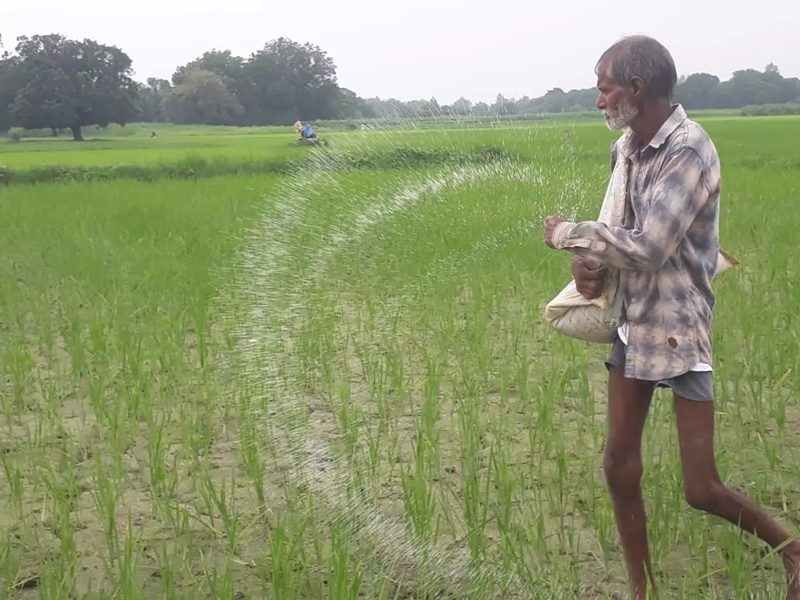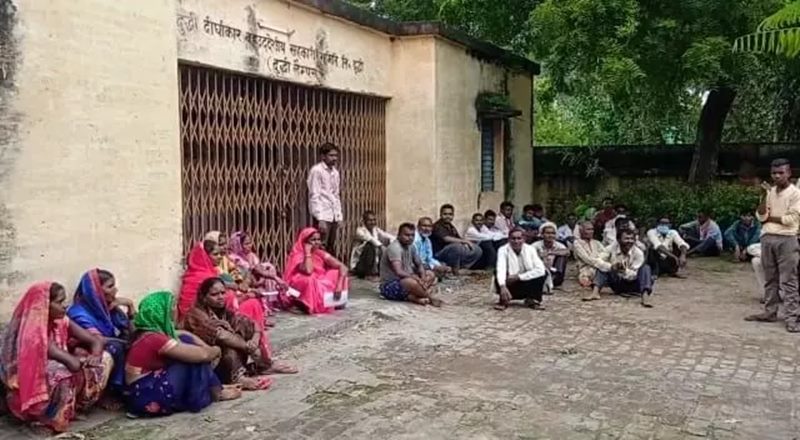In peak kharif season, farmers in Uttar Pradesh face urea shortage; govt claims enough supply of the fertiliser
Farmers urgently need urea for their paddy crops but are unable to get it from the co-operative stores. Some are forced to pay way more than the government-fixed rate for urea. The state government has promised to take severe action on black marketeers of urea.

It is time for the paddy crops to be sprinkled with urea. But farmers in Uttar Pradesh are struggling to obtain urea from co-operative societies, and are being forced to buy them at exorbitant rates outside. This, despite the state government declaring that there is enough urea available in the state and action will be taken on anyone found selling it the black market and their license to sell urea will be cancelled.
The government rate of one sack of urea weighing 45 kilogrammes (kg) is Rs 266.50. However, in several districts of Uttar Pradesh, the farmers complain they are being forced to pay more than the government-fixed rate.
“I have been coming here every day for a week now to buy urea. But each day we are told it will come the following day. The urea is there in the godown, but it is not being distributed,” Rajpathi, a farmer from Jharukala village in Sonbhadra district, complained to Gaon Connection.

Rajpathi had just been turned back from the Duddhi Deepankar Co-operative Society, as had a long queue of farmers who had waited there for hours to buy urea. “It is valuable time the farmers have wasted,” Rajpathi said. She demanded to know where the stored urea in the godown was going. “If they are sending us back empty handed, surely the urea is being sold in the black market,” he alleged.
About 400 kms away from Sonbhadra, in Tandi village, Barabanki district, paddy farmer Anil Varma is frustrated too. He has four acres of paddy for which he requires at least three to four sacks of urea, but he has not been able to procure that quantity.
“I managed to get just one sack of urea. How do I make do with that for my four-acre paddy crop,” a frustrated Varma asked. “Even for that one sack of urea I had to pay four hundred rupees whereas the government rate is no more than two hundred and sixty six rupees and fifty paise,” he told Gaon Connection.
“There is no urea in the government centres, the price of petrol and diesel is hiked… it looks like the government wants to finish off the farmers,” the paddy farmer lamented.
Also Read: Burdened by rising diesel prices and increasing irrigation cost, paddy farmers reduce their acreage
Paddy is the main kharif crop in the country, and is cultivated in almost all the states. It is a vital crop for ensuring food security and timely application of urea is crucial.
For a healthy and high yielding crop of paddy, there has to be a balanced use of urea, say agricultural scientists. “At the moment the paddy crop is already between thirty and fifty days old. This is when the plant starts developing,” Dheeraj Tiwari, agricultural scientist of the Krishi Vigyan Kendra, Dhaora, Unnao, told Gaon Connection.
It is when the paddy requires nitrogen for its growth and that is provided by the urea, Tiwari said adding that it was imperative the farmers use urea on their crops at this stage.

Also Read: Tackling the menace of leaf roller pests, with nothing more than a plastic rope
No shortage of urea, says minister
Uttar Pradesh is one of the principal states in the country cultivating paddy. According to the agriculture department of the state, in Uttar Pradesh nearly 5.8-5.9 million hectares are under paddy cultivation. In 2019-20, there was paddy cultivation in 5.941 million hectares of land that yielded 17.136 million metric tonnes of produce.
In a recent meeting on August 3, Surya Pratap Shahi, the minister for agriculture, Uttar Pradesh held with officials of the agriculture department and manufacturers of fertilisers in the state, he said there was no shortage of urea, DAP ( diammonium phosphate) or NPK (nitrogen, phosphorus, and potassium) fertilisers in the state. He also said that of the quota of 3.35 million metric tonne of urea for the month of August, 3.06 million metric tonne has been supplied to the state.
For the kharif season, so far 2.009 million metric tonnes of urea has already been distributed, and 1.041 million metric tonnes is yet to be distributed, the minister informed.
Also Read: Amid fertiliser price hike, this is what IFFCO — India’s largest fertiliser seller — had to say
He also cautioned urea dealers not to force the farmers to buy other products such as zinc along with the urea. Farmers have been complaining about this. He added that action would be taken against such dealers, and their licenses would be revoked.

‘Less urea supplied this year’
Despite the claims of the agriculture minister and the state government, the long lines of beleaguered farmers continue. In Sonbhadra district, which has a sizeable adivasi population and grows a lot of paddy, there is considerable shortage of urea, claim farmers.
“Last year Sonbhadra received nine thousand metric tonnes of urea. This year, so far we have only got four hundred and thirty seven metric tonnes of it,” Tribhuvan Singh, assistant registrar of the district cooperative society, informed Gaon Connection. The anger and frustrations of the farmers are justified, he added.
However, Sitapur district is faring better and there have not been any complaints from the farmers. The district has not faced any shortage of fertilisers, according to Navin Chandra Shukla, assistant registrar of the district.
Also Read: Water hyacinth — a nuisance for water bodies, can now be used to produce organic fertilisers
“Between August 1 and August 12, thirty one thousand metric tonnes of urea, five thousand eight hundred and seventy four metric tonnes of DAP and one thousand six hundred and seventy one metric tonnes of NPK have been made available to the farmers,” Shukla told Gaon Connection. “There is enough fertiliser to go around and we have not received any complaints so far,” he added.

In Unnao district, there is approximately 99,000 hectares of land under paddy cultivation. But, there are farmers who complain they are being forced to buy urea at higher rates, despite claims by the agriculture department that there is no shortage of urea in the district.
“There is no shortage of fertilisers in the district,” K K Mishra, district agriculture officer, Unnao, told Gaon Connection. “Twenty four thousand metric tonnes of fertilisers have been supplied so far for the kharif crop. We have formed a team that regularly goes on inspection to shops and the co operative societies to ensure the farmers face no shortage,” Mishra added.
Also Read: A plant-based hydrogel to help farmers tackle water scarcity in the face of climate change
But the farmers claim otherwise. “I bought fertilisers from a private shop for my one and a half hectare of paddy,” 65-year-old farmer Shivram from Behta Nathai Singh village, Unnao, told Gaon Connection. “I bought urea at three hundred rupees a sack and I know it is more than what the government price is. But I am helpless,” he rued.
“Farmers do not have so much time that they will wait till fertilisers are made available to them at the correct rates,” Singh added. “Our crops will spoil by then,” he pointed out.
Shortage of urea has been a thorn in the side of farmers across Uttar Pradesh, Madhya Pradesh, Bihar, Punjab.
Also Read: Traditional polyhouses get a makeover with retractable roofs
However, this year the introduction of nano urea has brought some relief. In liquid form, the nano urea needs to be used in less quantity when compared to the regular urea and is said to be as impactful. Also, the claims are that 500 ml of nano urea priced at Rs 240, works as hard as a 45-kg sack of traditional urea.
“I used the liquid urea for the first time. I bought ten bottles for two thousand four hundred rupees,” Baljinder Kasli of Vaslipur in Lakhimpur district, told Gaon Connection. He said he was happy with the results.
With inputs from Bhim Kumar in Sonbhadra, Sumit Yadav in Unnao, Mohit Shukla in Sitapur and Virendra Singh in Barabanki, Uttar Pradesh.
Read the story in Hindi.
Also Read: From walking five km to the village school to developing the world’s first liquid nano urea

